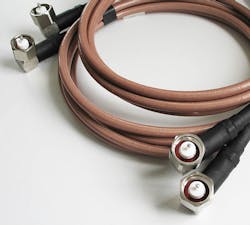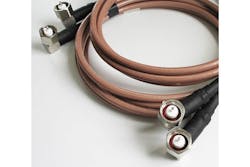Cables and connectors often go unnoticed in an RF/microwave circuit or system, until they fail to perform as expected. They provide fairly straightforward functions in a system, moving signals from one point to another. Ideally, they impart as little change as possible to those signals in terms of amplitude, frequency, and phase (short or long term), and they provide their connections with reliability that is at least as high as the rest of the system. Of course, signals and applications vary widely, as do the types of high-frequency cables and connectors. Hence, fitting cables, connectors, or cable assemblies to an application is most often about matching the characteristics of a particular cable or connector to the application.
Related Articles
• Cables & Connectors Forge Critical Links
• Low-PIM Cables Jump DC To 3 GHz
• Test Cables Link DC To 18 GHz
Choosing a cable can be as simple as deciding on a rigid or bendable type of cable—or more precisely, selecting between a semirigid and a flexible coaxial cable. Semirigid coaxial cables have been a staple of RF/microwave systems for decades, with outstanding electrical performance. As the name suggests, a semirigid cable offers very little flexibility and maneuverability, and usually must be cut and/or fit with connectors to precise required lengths to fit a system’s mechanical requirements. For its lack of flexibility, however, this type of coaxial cable exhibits typically less insertion loss than flexible cables with similar diameter and dimensions.
As a form of compromise between the two cable types, hand-formable cables provide some flexibility and the capability to bend a cable into a required shape without tools. It also achieves insertion loss that, while not at the low levels of semirigid cables, is often an improvement on the insertion-loss performance of flexible cables.
High-frequency cables are available from different suppliers at characteristic impedances of 50 and 75 Ω, the latter typically for use in cable-television (CATV) systems. Loss through the cable is usually specified as attenuation per 100 feet of cable at a given test frequency and, when comparing cables, it is important to use the same test frequency. Every cable will add some electrical length—essentially, the number of wavelengths for a length of cable assembly at a frequency of interest. The electrical length is usually specified in degrees of phase.
The cable’s electrical length can also be considered as a phase delay, or the time for a signal to travel from one end of the cable to the other compared to the time that the same signal would travel through an air line of equivalent length. As a phase delay or propagation delay, this electrical length is usually specified in nanoseconds. The dielectric constant of the insulating material between a cable’s center conductor and outer conductor has a great impact on the propagation delay, since it influences the conduction of signal along the cable. For minimal signal delay, an insulating material with low dielectric constant is usually packed between a high-frequency coaxial cable’s inner conductor and outer conductor.
Some commercial suppliers of coaxial cables, such as Micro-Coax, offer helpful application notes on selecting cables and the impact on performance of different cable materials. One of the firm’s more insightful notes, “Solid VS. Stranded Center Conductors,” highlights the differences among a coaxial cable with a solid center conductor and two types of stranded cables (one with 7 strands and one with 19). All three cables are terminated with SMA connectors and tested from DC to 18 GHz.
In manufacturing these cables, the goal is to maintain consistent impedance. In the cable with a solid center conductor, this is a matter of minimizing variations in inner and outer conductor diameters. For the cables with stranded conductors, the stranded center conductors must have each wire in the strand held to tight dimensional tolerances to maintain the impedance of the cable. This is difficult to accomplish with stranded conductors, and makes the process of manufacturing these cables more expensive than for cables with a solid center conductor. However, the stranded center conductor has many advantages, including durability and flexibility.
From the measurements, the cable with solid conductor exhibits the lowest attenuation with frequency, followed by the cable with 7 strands and then the cable with 19 strands in its center conductor (highest loss). For each cable, this signal attenuation also increases with increasing temperature. The cable with solid center conductor shows the best amplitude stability with flexure, followed by the cable with 19 strands in the center conductor and the cable with 7 strands in the center conductor (worst amplitude stability with flexure).
In terms of phase stability with flexure, the cables with stranded center conductors show the best results, with the cable having 7 strands in the center conductor the least sensitive to changes in phase with flexure, followed by the cable with 19 strands in the center conductor, and the cable with solid center conductor being the most susceptible to changes in phase with flexure. Finally, for an application (such as in a test system) where a large number of flexures was needed, the cables with stranded center conductors will last considerably longer than the cable with solid center conductor, which tended to wear out after 10,000 flexures.
New Innovations
Cable suppliers continue to find new solutions based on ingenious combinations of materials, such as the Strip Flex Taped (STF™) series of cables and cable assemblies from Times Microwave Systems. Although they are flexible, they can also handle high power levels with good phase stability at cutoff frequency as high as 63 GHz, depending upon diameter (see figure). They are suitable for ground-based and airborne applications.
The STF™ series of cables and cable assemblies operate as high as 63 GHz with high power-handling capability, low loss, and good phase stability. (Photo courtesy of Times Microwave Systems.)
Connectors intended to fit on the end of high-frequency cables should be dimensionally similar to those cables, so as to minimize impedance discontinuities between the connectors and cables as much as possible. The physical size of coaxial connectors generally shrinks with increasing frequency, with larger connectors such as BNC and Type-N connectors cutting off at lower frequencies than smaller connectors such as SMA types. Every connector type will exhibit a moding frequency, which is its upper-frequency limit, with Type-N connectors initially developed for use through 12 GHz.
Coaxial connectors were initially designed with screw-on type interfaces and for particular applications, such as the Type-N connectors developed for US Navy shipboard applications. But for some applications requiring faster interconnections between pairs of similar connectors—such as in test-and-measurement applications—screw-on connectors were supplemented by connector types with push-on interfaces, such as SMA connectors.
Related Articles
• Cables & Connectors Forge Critical Links
• Low-PIM Cables Jump DC To 3 GHz
• Test Cables Link DC To 18 GHz
Over time, the moding frequencies of many connector types has been extended, with some Type-N connectors now operating as high as 18 GHz and some SMA connectors working past 30 GHz. Quite simply, smaller connector dimensions mean higher moding frequencies. Pioneering work by such innovators as Bill Oldfield at Anritsu/Wiltron and Julius Botka at Agilent/Hewlett-Packard Co. have pushed coaxial connectors well into the millimeter-wave frequency range.
Of course, this short piece can barely scratch the surface of important details on specifying coaxial cables and connectors. The requirements of a particular application—including temperature, vibration, power-handling capability, intermodulation distortion (IMD), frequency range, and phase stability—will help establish the performance minimums for the cables and connectors in that application, and those requirements will vary widely for test and system applications. Many of the leading cable and connector suppliers offer excellent white papers and application notes that can help simplify the selection process.
About the Author
Jack Browne
Technical Contributor
Jack Browne, Technical Contributor, has worked in technical publishing for over 30 years. He managed the content and production of three technical journals while at the American Institute of Physics, including Medical Physics and the Journal of Vacuum Science & Technology. He has been a Publisher and Editor for Penton Media, started the firm’s Wireless Symposium & Exhibition trade show in 1993, and currently serves as Technical Contributor for that company's Microwaves & RF magazine. Browne, who holds a BS in Mathematics from City College of New York and BA degrees in English and Philosophy from Fordham University, is a member of the IEEE.

